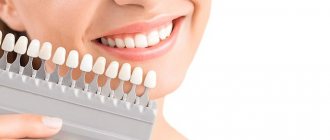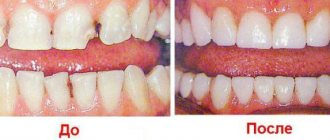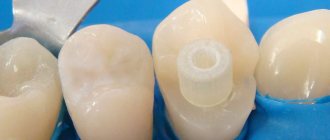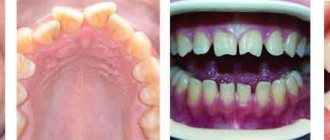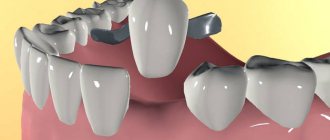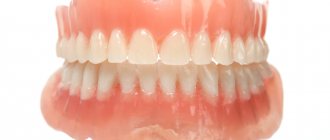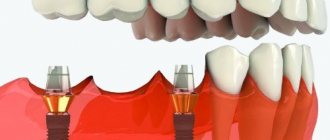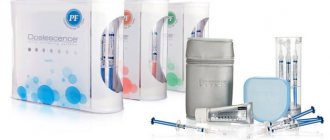Teeth whitening in dentistry
It seems to modern people that snow-white teeth have always been an integral attribute of an attractive appearance, but this is far from the case. During the Roman Empire, wearing gold dentures was considered a blessing—a symbol of power and prosperity (by the way, in Russia, gold crowns once played the same role). The aristocracy of the Middle Ages was proud of rotten teeth - a sign of high origin and wealth. In Ancient China, things were no better: women deliberately made their smile black in order to please the future groom. Of course, darkened teeth were not held in high esteem everywhere and not at all times, and there were people who were looking for more and more new means for whitening them.
What do experts recommend?
Dentists advise: before choosing a way to improve the color of your teeth, you need to decide what you want to get in the end. If the problem is dark deposits from food, drinks or smoking, then you should first carry out a comprehensive professional cleaning (ultrasound + Air Flow). Perhaps pure, natural-toned enamel is the result you were expecting. If the ideal is a snow-white “Hollywood” smile, then you need to take the next step - perform ZOOM-4. The planned shade can be selected together with your doctor according to the Vita scale. To achieve a more lasting effect, experts advise carrying out this procedure first in the clinic, then performing it at home.
The dental chain offers teeth whitening services using a variety of methods. We have family and cumulative discounts. Doctors are highly qualified and continue to improve their skills in leading Russian and European dental clinics. The level of medical services provided meets international standards.
Branches of our orthodontic center are located in Moscow within walking distance from the metro:
- Art. Alekseevskaya (VDNKh district, etc. Mira), address: st. 3rd Mytishchiskaya house 3, building 2;
- Art. Shelepikha, address: Shelepikhinskaya embankment, address: building 34, building 1.
We will make your smile beautiful! Come to us for health and beauty!
Teeth whitening methods
All types of teeth whitening can be divided into professional and non-professional. The first ones are carried out by a doctor in a clinic or by the patient himself at home under the supervision of a doctor. These include methods such as photobleaching, laser, chemical bleaching, endobleaching and home whitening using caps. Each of the listed methods of teeth whitening has its own pros and cons, indications and contraindications.
The second group includes various whitening products that can be purchased freely and used independently without the participation of a specialist. We are talking, first of all, about whitening pastes. Non-professional whitening includes special whitening plates, pencils and systems with universal trays, but doctors still do not recommend using them yourself, since careless use of such products can lead to complications such as sharp pain during whitening and increased tooth sensitivity after it.
Contraindications
In some cases, teeth whitening is not just harmful, but unacceptable. Your doctor will determine whether you can whiten your teeth or not. If a patient has contraindications, but still whitens his teeth, he may face serious oral diseases.
Diseases and conditions for which teeth whitening is contraindicated:
- open caries;
- pathological abrasion of enamel;
- deep cracks in teeth;
- gum disease;
- wearing braces;
- exposure of tooth roots;
- allergy to bleaching agents.
In addition, teeth whitening is contraindicated for minors, as well as pregnant and breastfeeding women.
Effective teeth whitening
Before the patient agrees to whitening, the doctor must warn that the results may be disappointing. This is especially true for complex cases, such as teeth with fluorosis. In addition, the patient should be warned about the possible replacement of old restorations. Whitening of fillings, crowns, veneers or implants is not possible.
The most effective methods of teeth whitening are professional techniques. The leading place in terms of effectiveness is occupied by laser whitening, which to some extent can even cope with tetracycline teeth. Then comes photobleaching - the most famous and popular in-office technique today. Closing the top three is the chemical technique, which is used very rarely, but definitely deserves attention. Home professional whitening is also quite effective, but to get results you need to take a fairly long course.
As for non-professional whitening systems, the most effective of them are those that contain hydrogen peroxide or carbamide peroxide. All other products without the listed active whitening substances have only a good cleaning effect from plaque and polishing the tooth surface.
If we talk about the effectiveness of whitening in general, then, even when using the same product, different patients will have different results. The best and fastest effect is achieved by whitening teeth with natural yellowish tints; teeth with grayish shades are less bleached. And although everything depends on the specific case, to say that the effect of the procedure is completely unpredictable is also wrong. A dentist who has good practice can predict the outcome in simple clinical cases.
Anatomy of tooth enamel
Enamel is a protective layer covering the crown of a tooth. It is the hardest tissue in the human body, since it consists of 97% inorganic substances: fluorine, iron, lead, zinc, carbonates, magnesium, sodium, copper, aluminum, potassium, strontium and others. The organic matter of enamel consists of proteins, carbohydrates and lipids. In different areas, the enamel shell has different thicknesses, reaching a maximum in the area of the tubercles. Its surface layers have the highest hardness, but at the same time they are very fragile, especially near the neck of the teeth, where the thickness of the enamel is only about 0.01 mm.
The main structural formation of enamel is enamel prisms - structures formed from hydroxyapatite crystals with a diameter of no more than 4-6 microns, having a tortuous shape, due to which their length exceeds the thickness of the enamel. When collected in bundles, the prisms form s-shaped bends, so light and dark stripes, as well as oblique lines, can be seen on enamel sections. In addition to prisms, tooth enamel contains spindles, fascicles and plates - formations that penetrate the enamel to small, medium and large depths, respectively. The inner and outer layers of enamel running at the cemento-enamel boundary do not have prisms and are therefore called prismless enamel. The main function of enamel is to protect dentin and pulp from external influences - temperature, mechanical and chemical, and thanks to the characteristics of the strength and hardness of enamel, we can bite, grind and grind even coarse and hard food without damaging the teeth.
Composition of whitening gels
For various methods of professional and non-professional teeth whitening, special whitening gels are used, the active substances of which are hydrogen peroxide or carbamide. Sometimes the preparations include amorphous calcium phosphate, fluoride or potassium nitrate to treat minor damage to the enamel, as well as to make teeth brighter and glossier after the procedure. In some cases, the whitening gel may contain special components that have a soothing effect on the teeth and gums.
Desk techniques
Some methods of achieving a snow-white smile require manipulation only in a dental clinic using special equipment.
They can only be carried out by specialists who have undergone qualified training. All methods are effective and at the same time safe for the health of patients. This is confirmed by certificates and mandatory clinical trials. Lightening and bleaching methods:
- laser cleaning – laser treatment of deposits;
- ultrasonic cleaning. It is performed using a device that generates ultrasound (scaler). It destroys hard mineralized plaque, in other words, tartar;
- Air Flow hardware technology also belongs to the arsenal of professional hygiene. Its essence is the effect on soft deposits of a directed stream of a mixture of water, air and the smallest granules of soda. This composition softens and washes away dirt even in the interdental spaces;
- ZOOM-4 is a chemical option for treating enamel with hydrogen peroxide under the influence of a special lamp. Radiation is a chemical catalyst. a process in which atomic oxygen is released from hydrogen molecules and destroys pigment. This procedure is also called photobleaching, because light radiation becomes the activator of the process. The surface to be treated must first be thoroughly cleaned. It is performed with ultrasound and Air Flow hardware cleaning.
Expert opinion: it is important to distinguish between lightening and bleaching. Lightening is the achievement of a natural shade by “removing” impurities, and bleaching is the chemical destruction of natural pigment. This can make your teeth literally snow-white.
Teeth whitening procedure
In the whitening procedure, it is very important to strictly follow its protocol.
- Before you start whitening your teeth, you need to conduct a diagnosis: find out the reason for the change in the color of the tooth enamel, take an x-ray, examine the gums and check the condition of the teeth. Based on the data obtained, the doctor selects the whitening system that is most suitable in this case.
- This is followed by mandatory professional teeth cleaning.
- Before and after the whitening procedure, remineralization therapy is performed.
- Rapid in-office teeth whitening is performed in the clinic directly by a dental hygienist. A gel with a whitening agent concentration of at least 30% is applied to the teeth, which is activated by light, laser, or acts on its own. The duration of the procedure depends on the specific technique, but, as a rule, only one visit is required. For home whitening in dentistry, individual trays are made, and a suitable whitening gel is selected. The patient carries out the procedure itself at home, following the doctor’s recommendations. The gel is applied to trays, which are placed on the teeth and worn once or twice a day or left overnight, depending on the teeth whitening technology. The course can last from two weeks to a month.
- At the end of the procedure, the result obtained is assessed using the VITA scale.
Important!
After teeth whitening, you should not smoke, drink red wine or coffee, or consume any foods with strong coloring pigments, such as red berries and beets.
The effect of white teeth can last from six months to several years. It is very difficult to say exactly how long teeth whitening will last, since it depends on many factors. To maintain long-term results, it is recommended to use maintenance whitening products for home use - pastes or rinses, as well as adhere to a transparent diet. In addition, good oral care and regular professional cleanings can also help maintain a snow-white smile for a long time. It is likely that sooner or later the procedure will have to be repeated, but according to many experts, the original color of the teeth will not return.
Color and optical properties of enamel and dentin
The color of teeth has several basic characteristics - shade, intensity, transparency, as well as several additional optical properties that are difficult to detect by the human eye. These include opacity (low light transmittance, opacity), fluorescence (glow), surface gloss and others. Tooth enamel is practically colorless, but has properties important for the vitality of the tooth: transparency, shine, fluorescence and opalescence (the ability to scatter light). The color of the tooth is maximally manifested in the dentin layers. The pigments they contain are capable of selectively reflecting light rays, creating individual shades of the crown of the tooth. The characteristic protrusions of dentin (mamelons) are almost always bordered by milky blue enamel with a cream rim along the cutting edge. This optical phenomenon is called the halo effect, and without it the tooth would not have visually defined boundaries and would blend into the dark oral cavity. It is important to understand that the healthy state of dentin (including the “health” of its optical properties) provides a beautiful tooth color and, on the contrary, due to disorders and pathologies of the dentin layers, the color of the teeth changes significantly.
Complications after teeth whitening
The most common problem that patients encounter after whitening is increased tooth sensitivity. The cause of painful sensations is the process as a result of which the teeth, under the influence of the whitening gel, lose moisture and are then re-saturated with liquid. Remineralizing therapy before the procedure and the use of special medications help neutralize pain after teeth whitening. Increased tooth sensitivity can also be relieved by taking painkillers.
Reasons for changes in enamel color
Not all people's teeth need whitening, even if there are signs of discoloration. Thus, the teeth of representatives of the Negroid race always look white due to the contrast with the color of their skin. But for fair-skinned people, teeth whitening is a pressing issue. In almost every person, most emerging teeth have a thick, uniform layer of enamel, which modifies the underlying color of the underlying dentin and gives the teeth a beautiful milky white hue associated with youth, health and physical attractiveness. But over time, most people's teeth change color. Sometimes this happens even before eruption under the influence of medications (for example, tetracycline antibiotics) to treat a particular disease.
But in the vast majority of cases, tooth discoloration is caused by age-related changes under the influence of environmental factors. Any disturbances in the structure of dentin, microcracks in the structure of enamel contribute to the accumulation of pigment substances that change the color of teeth to a darker one. The consumption of tea, coffee, tobacco, and foods with a high content of chemical dyes has a particularly strong effect on the surface layers of teeth. Also, color change occurs due to the penetration of various compounds into the hard tissues of teeth due to long-term use of medications, dental treatment with drugs that cause pigmentation, and other factors. Installing composite restorations, veneers, and crowns can solve the problem of dental discoloration, but the use of these methods changes the dental structure, while professional whitening is the most minimally invasive method in modern dentistry.
